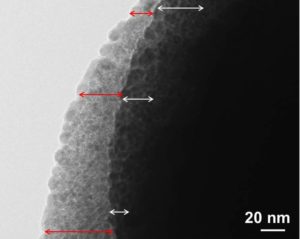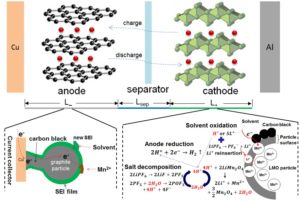Battery model and simulation
We create validated battery material, cell and pack models. These models optimize the battery design and architecture to achieve higher energy density, power density, and cycle life. Through advanced control, these models help to achieve optimal battery performance and cycle life for any given battery cell or pack by optimizing how it is used. These physics-based models are the foundations of smart battery management systems. These models also significantly reduce experimental time/cost for battery testing.
In particular, we develop comprehensive battery degradation models that couple electrochemical, mechanical and thermal processes. These models enable us to understand, analyze and predict degradation and cycle life of the battery material and battery system. For instance, high-capacity electrode materials experience high volume expansion/contraction, resulting in fracture and pulverization of particles, and fast degradation in capacity. This is coupled with processes such as SEI formation and material dissolution, leading to complex degradation behaviors. Degradation models allow us to optimize the electrode material, battery design and application strategy to achieve long battery cycle life. Building on battery models and experimental data, we also develop machine learning to predict and optimize the battery design and performance.
Battery is a multiscale and multiphysics system. We consider scales from continuum to particle and molecular levels, and particle interactions. We also incorporate various side reactions in the models, including SEI growth, deposition, dissolution, electrolyte oxidation and salt decomposition.
Advanced battery materials
We develop and synthesize advanced high capacity electrode materials, such as black phosphorus, silicon, and lithium metal electrodes. These include innovative material synthesis of black phosphorus, nanoporous silicon, nano/micro-structured Si/CNT/C composites, improved binding systems, and gel polymer electrolyte. We perform various material characterization (TEM, SEM, AFM, XPS, XRD etc.). Our lab has comprehensive facility for cell fabrication (coin cells, pouch cells, specialized cells such as 3-electrode, fluid, or in-situ electrochemical cells), cell performance testing (cycling, EIS, thermal, dissolution, degradation, etc.), and in-situ material characterization such as AFM.


Advanced smart battery management system
Recent progress in battery technology has made it possible to use batteries to power various physical platforms, such as ground/air/water vehicles. Current state-of-the art needs significant improvements in the architecture and algorithms of battery management before achieving the desired levels of efficiency and performance. We develop new comprehensive battery management architecture, called Smart Battery Management System (SBMS). The architecture incorporates battery state-of-charge and state-of-health algorithms as well as battery power management strategies on both pack and cell levels.
Selected publications in battery area
T. Gao, D. Barnes, and W. Lu, “Theory of coupled electrochemistry and piezoelectricity in a porous medium,” Physical Review Letters, 128, 068301, 2022.
T. Gao, G. Liu, and W. Lu, “A theory that couples electrochemistry and thin film piezoelectricity with stability analysis for electrodeposition,” Journal of the Mechanics and Physics of Solids, 162, 104827, 2022.
J. Zhang and W. Lu, “Sparse data machine learning for battery health estimation and optimal design incorporating material characteristics,” Applied Energy, 307, 118165, 2021.
X. Lin, K. Khosravinia, X. Hu, J. Li, and W. Lu, “Lithium plating mechanism, detection, and mitigation in lithium-ion batteries,” Progress in Energy and Combustion Science, 87, 100953, 2021.
C. Deng and W. Lu, “A facile process to fabricate phosphorus/carbon xerogel composite as anode for sodium ion batteries,” Journal of The Electrochemical Society, 168, 080529, 2021.
J. Zhang, H. Shin, and W. Lu, “Top-down ultrasonication-assisted exfoliation for prebonded phosphorene-graphene heterostructures enabling fast lithiation/delithiation,” ACS Applied Materials & Interfaces, 13, 25946–25959, 2021.
T. Gao and W. Lu, “Machine learning toward advanced energy storage devices and systems,” iScience, 24, 101936, 2021.
T. Gao, C. Rainey, and W. Lu, “Piezoelectric mechanism and a compliant film to effectively suppress dendrite growth,” ACS Applied Materials & Interfaces, 12, 51448–51458, 2020.
T. Gao, A. Kim, and W. Lu, “Modeling electrode-level crack and quantifying its effect on battery performance and impedance,” Electrochimica Acta, 363, 137197, 2020.
C. Deng and W. Lu, “Consistent diffusivity measurement between Galvanostatic Intermittent Titration Technique and Electrochemical Impedance Spectroscopy,” Journal of Power Sources, 473, 228613, 2020.
T. Gao and Wei Lu, “Physical model and machine learning enabled electrolyte channel design for fast charging,” Journal of The Electrochemical Society, 167, 110519, 2020.
G. Liu, D. Wang, J. Zhang, A. Kim, and W. Lu, “Preventing dendrite growth by a soft piezoelectric material,” ACS Materials Letters, 1, 498-505, 2019.
B. Wu and W. Lu, “A consistently coupled multiscale mechanical-electrochemical model with particle interaction and its validation,” Journal of the Mechanics and Physics of Solids, 125, 89-111, 2019.
H. Shin, J. Zhang, and W. Lu, “Material structure and chemical bond effect on the electrochemical performance of black phosphorus-graphite composite anodes,” Electrochimica Acta, 309, 264-273, 2019.
J. Zhang, H. Shin, and W. Lu, “Highly ambient-stable few-layer black phosphorene by pulsed laser exfoliation and HEMM,” Chemical Communications, 55, 2601-2604, 2019.
T. Gao and W. Lu, “Mechanism and effect of thermal degradation on electrolyte ionic diffusivity in Li-ion batteries: A molecular dynamics study,” Electrochimica Acta, 323, 134791, 2019.
Y. K. Lee, J. Park, and W. Lu, “A comprehensive experimental and modeling study on dissolution in Li-ion batteries,” Journal of the Electrochemical Society, 166, A1340-A1354, 2019.
H. Shin, J. Zhang, and W. Lu, “A comprehensive study of black phosphorus-graphite composite anodes and HEMM synthesis conditions for improved cycle stability,” Journal of the Electrochemical Society, 166, A2673-A2682, 2019.
X. Lin and W. Lu, “A framework for optimization on battery cycle life,” Journal of the Electrochemical Society, 165, A3380-A3388, 2018.
B. Wu, S. Han, K.G. Shin, W. Lu, “Application of artificial neural networks in design of lithium-ion batteries,” Journal of Power Sources, 395, 128-136, 2018.
B. Wu and W. Lu, “Mechanical modeling of particles with active core-shell structures for lithium-ion battery electrodes,” The Journal of Physical Chemistry C , 121, 19022–19030, 2017.
B. Wu and W. Lu., “A battery model that fully couples mechanics and electrochemistry at both particle and electrode levels by incorporation of particle interaction,” Journal of Power Sources, 360, 360, 2017.
G. Liu and W. Lu, “A model of concurrent lithium dendrite growth, SEI growth, SEI penetration and regrowth,” Journal of the Electrochemical Society, 164, A1826, 2017.
X. Lin and W. Lu, “A battery model that enables consideration of realistic anisotropic environment surrounding an active material particle and its application,” Journal of Power Sources, 357, 220, 2017.
Y. K. Lee, J. Park and W. Lu, “A comprehensive study of manganese deposition and side reactions in Li-ion battery electrode,” Journal of the Electrochemical Society, 164, A2812, 2017.
B. Wu and W. Lu, “Mechanical-electrochemical modeling of agglomerate particles in lithium-ion battery electrodes,” Journal of the Electrochemical Society, 163, A3131-A3139, 2016.
S. Lee, J. Yang and W. Lu, “Debonding at the interface between active particles and PVDF binder in Li-ion batteries,” Extreme Mechanics Letters, 7, 18–26, 2016.
J. Park, J. Li, W. Lu and A. M. Sastry, “Geometric consideration of nanostructures for energy storage systems,” Journal of Applied Physics, 119, 025101, 2016.
Y. Bie, J. Yang, W. Lu, Z. Lei, Y. Nuli and J. Wang, “A facile 3D binding approach for high Si loading anodes,” Electrochimica Acta, 212, 141–146, 2016.
Y. Bie, J. Yang, X. Liu, J. Wang, Y. Nuli and W. Lu, “Polydopamine wrapping silicon cross-linked with polyacrylic acid as high-performance anode for lithium-ion batteries,” ACS Applied Materials & Interfaces, 8, 2899–2904, 2016.
Y.K. Lee, J. Park and W. Lu, “Electronic and bonding properties of LiMn2O4 spinel with different surface orientations and doping elements and their effects on manganese dissolution,” Journal of the Electrochemical Society, 163, A1359-A1368, 2016.
H. Shin, J. Park, A. M. Sastry and W. Lu, “Degradation of the solid electrolyte interphase induced by the deposition of manganese ions,” Journal of Power Sources, 284, 416–427, 2015.
H. Shin, J. Park, A. M. Sastry and W. Lu, “Effects of fluoroethylene carbonate (FEC) on anode and cathode interfaces at elevated temperatures,” Journal of the Electrochemical Society, 162, A1683-A1692, 2015.
Y. Bie, J. Yu, J. Yang, W. Lu, Y. Nuli and J. Wang, “Porous microspherical silicon composite anode material for lithium ion battery,” Electrochimica Acta, 178, 65-73, 2015.
H. Shin, J. Park, S. Han, A. Sastry and W. Lu, “Component-/structure-dependent elasticity of solid electrolyte interphase layer in Li-ion batteries: experimental and computational studies,” Journal of Power Sources, 277, 169–179, 2015.
R. Miao, J. Yang, Y. Wu, J. Wang, Y. Nulia and W. Lu, “Nanoporous silicon from low-cost natural clinoptilolite for lithium storage,” RSC Advances, 5, 56772-56779, 2015.
Q. Lu, J. Yang, W. Lu, J. Wang, Y. Nuli, “Advanced semi-interpenetrating polymer network gel electrolyte for rechargeable lithium batteries,” Electrochimica Acta, 152, 489-495, 2015.
G. Y. Liu, P. Powell and W. Lu, “Nano-batteries in a carry fluid as power supply: Freeform geometry, superfast refilling, and heat self-dissipation,” Applied Physics Letters, 105, 253902, 2014.
M. Zhu, J. Park, A. M. Sastry and W. Lu, “Numerical study of interaction and aggregation of non-spherical particles in forming Li-Ion battery cathodes,” Journal of the Electrochemical Society, 161, A1247-A1252, 2014.
L. Liu, J. Park, X. K. Lin, A. M. Sastry and W. Lu, “A thermal-electrochemical model that gives spatial-dependent growth of solid electrolyte interphase in a Li-ion battery,” Journal of Power Sources, 268, 482-490, 2014.
S. Lee, J. Park, J. Yang and W. Lu, “Molecular dynamics simulations of the traction-separation response at the interface between PVDF binder and graphite in the electrode of Li-ion batteries,” Journal of the Electrochemical Society, 161, A1218-A1223, 2014.
J. L. Yu, J. Yang, X. J. Feng, H. Jia, J. L. Wang and W. Lu, “Uniform carbon coating on silicon nanoparticles by dynamic CVD process for electrochemical lithium storage,” Industrial & Engineering Chemistry Research, 53, 12697-12704, 2014.
X. G. Hao, X. K. Lin, W. Lu and B. M. Bartlett, “Oxygen vacancies lead to loss of domain order, particle fracture, and rapid capacity fade in lithium manganospinel (LiMn2O4) batteries,” ACS Applied Materials & Interfaces, 6, 10849-10857, 2014.
X. J. Feng, J. Yang, Y. T. Bie, J. L. Wang, Y. N. Nuli and W. Lu, “Nano/micro-structured Si/CNT/C composite from nano-SiO2 for high power lithium ion batteries,” Nanoscale, 6, 12532-12539, 2014.
X. Lin, J. Park, L. Liu, Y. Lee, A.M. Sastry and W. Lu, “A comprehensive capacity fade model and analysis for Li-ion batteries,” Journal of the Electrochemical Society, 160, A1701-A1710, 2013.
S. Lee, J. Park, A.M. Sastry and W. Lu, “Molecular dynamics simulations of SOC-dependent elasticity of LixMn2O4 spinels in Li-Ion batteries,” Journal of the Electrochemical Society, 160, A968-A972, 2013.
S. Han, J. Park, W. Lu and A.M. Sastry, “Numerical study of grain boundary effect on Li+ effective diffusivity and intercalation-induced stresses in Li-ion battery active materials,” Journal of Power Sources, 240, 155-167, 2013.
J. Park, W. Lu, and A.M. Sastry, “Numerical simulation of stress evolution in lithium manganese dioxide particles due to coupled phase transition and intercalation,” Journal of the Electrochemical Society, 158, A201-A206, 2011.
J. Park, J.H. Seo, G.L. Plett, W. Lu and A.M. Sastry, “Numerical simulation of the effect of the dissolution of LiMn2O4 particles on Li-ion battery performance,” Electrochemical and Solid State Letters, 14, A14-A18, 2011.












